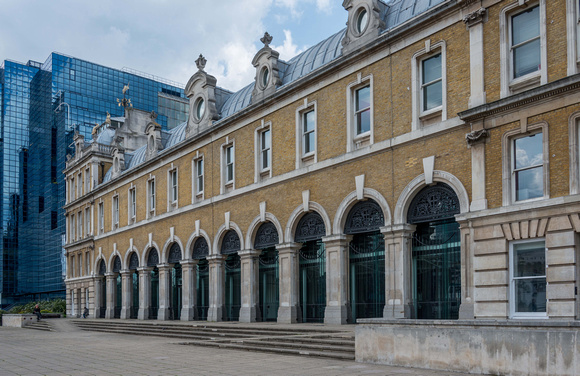The impressive facade of Billingsgate
Billingsgate Wharf, close to Lower Thames Street, became the centre of a fish market during the 16th and 17th centuries but did not become formally established until an Act of Parliament in 1699.[2]In 1850, the market according to Horace Jones, "consisted only of shed buildings ... The open space on the north of the well-remembered Billingsgate Dock was dotted with low booths and sheds, with a range of wooden houses with a piazza in front on the west, which served the salesmen and fishmongers as shelter, and for the purposes of carrying on their trade." In that year the market was rebuilt to a design by J.B. Bunning, the City architect.[3]Bunning's buildings was soon found to be insufficient for the increased trade, and in 1872 the Corporation obtained an Act to rebuild and enlarge the market, which was done to plans by Bunning's successor as City architect Sir Horace Jones. The new site covered almost twice the area of the old, incorporating Billingsgate Stairs and Wharf and Darkhouse Lane. Work began in 1874, and the new market was opened by the Lord Mayor on 20 July 1877. The new buildings, Italianate in style, had on their long frontages towards Thames Street the river, a pedimented centre and continuous arcade, flanked at each end by a pavilion tavern. The general market, on a level with Thames Street, had an area of about 30,000 square feet, and was covered with louvre glass roofs, 43 feet (13 m) high at the ridge. A gallery 30 feet (9.1 m) wide was allocated to the sale of dried fish, while the basement, served as a market for shellfish.[3]The opening of the railways changed the nature of the trade, and by the late nineteenth century most of the fish arrived at the market via the Great Eastern Railway.[3]The infamously coarse language of London fishmongers made "Billingsgate" a byword for crude or vulgar language.[4] One of its earliest uses can be seen in a 1577 chronicle by Raphael Holinshed, where the writer makes reference to the foul tongues of Billingsgate oyster-wives. The market is depicted during Tudor times in Rosemary Sutcliff's 1951 children's historical novel The Armourer's House. The writer George Orwell worked at Billingsgate in the 1930s, as did the Kray twins in the 1950s.


